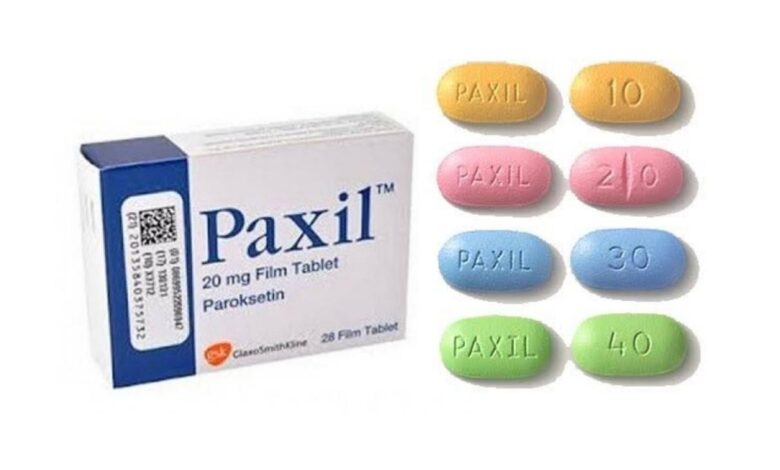Paxil (Paroxetine): Uses, Dosage, Side Effects, Interactions

What is Paxil?
Paxil is a brand of paroxetine an antidepressant that belongs to a group of drugs called selective serotonin reuptake inhibitors (SSRIs). Paxil tablets, suspension (liquid), and the extended-release (long-acting) tablets are used to treat depression, panic disorder (sudden, unexpected attacks of extreme fear and worry about these attacks), and social anxiety disorder (extreme fear of interacting with others or performing in front of others that interferes with normal life).
Paxil tablets and suspension are also used to treat obsessive-compulsive disorder (bothersome thoughts that won’t go away and the need to perform certain actions over and over), generalized anxiety disorder (GAD; excessive worrying that is difficult to control), and posttraumatic stress disorder (disturbing psychological symptoms that develop after a frightening experience). Paxil extended-release tablets are also used to treat premenstrual dysphoric disorder (PMDD, physical and psychological symptoms that occur before the onset of the menstrual period each month).
Paroxetine capsules are used to treat hot flashes (sudden feelings of warmth, especially in the face, neck, and chest) in women who are experiencing menopause (stage of life when menstrual periods become less frequent and stop and women may experience other symptoms and body changes).
Paxil is also sometimes used to treat chronic headaches, tingling in the hands and feet caused by diabetes, and certain male sexual problems. Paxil is also used with other medications to treat bipolar disorder (mood that changes from depressed to abnormally excited). Talk to your doctor about the possible risks of using this drug for your condition.
This medication may be prescribed for other uses; ask your doctor or pharmacist for more information.
How Paxil works
Paxil is in a class of medications called selective serotonin reuptake inhibitors (SSRIs). It treats depression and other mental illnesses by increasing the amount of serotonin, a natural substance in the brain that helps maintain mental balance. There is not enough information available at this time to know how paroxetine works to treat hot flashes.
How should Paxil be taken?
Paxil comes as a tablet, a suspension (liquid), and a controlled-release (long-acting) tablet to take by mouth. The tablets, suspension, and controlled-release tablets are usually taken once daily in the morning or evening, with or without food. The capsules are usually taken once a day at bedtime with or without food. You may want to take paroxetine with food to prevent stomach upset. Take paroxetine at around the same time every day. Follow the directions on your prescription label carefully, and ask your doctor or pharmacist to explain any part you do not understand. Take paroxetine exactly as directed. Do not take more or less of it or take it more often than prescribed by your doctor.
Shake the liquid well before each use to mix the medication evenly. Swallow the extended-release and regular tablets whole; do not chew or crush them.
If you are taking paroxetine tablets, suspension, or controlled-release tablets, your doctor may start you on a low dose of paroxetine and gradually increase your dose, not more than once a week.
The capsule form of this medication contains a lower dose of paroxetine than is needed to treat depression and other forms of mental illness. Do not take paroxetine capsules to treat a mental illness. If you think you have depression or another mental illness, talk to your doctor about treatment.
Paxil may help control your symptoms but will not cure your condition. It may take several weeks or longer before you feel the full benefit of paroxetine. Continue to take paroxetine even if you feel well. Do not stop taking paroxetine without talking to your doctor. Your doctor may decrease your dose gradually. If you suddenly stop taking paroxetine tablets, suspension, or controlled-release tablets, you may experience withdrawal symptoms such as depression; mood changes; frenzied or abnormally excited mood; irritability; anxiety; confusion; dizziness; headache; tiredness; numbness, or tingling in the arms, legs, hands, or feet; unusual dreams; difficulty falling asleep or staying asleep; nausea; or sweating. Tell your doctor if you experience any of these symptoms when your dose of paroxetine is decreased.
What happens if I miss a dose of Paxil?
Take the medicine as soon as you can, but skip the missed dose if it is almost time for your next dose. Do not take two doses at one time.
What happens if I overdose on Paxil?
Seek emergency medical attention or call the Poison Help line at 1-800-222-1222. An overdose of paroxetine can be fatal.
What are the side effects of Paxil?
Paxil may cause side effects. Tell your doctor if any of these symptoms are severe or do not go away:
• headache
• dizziness
• weakness
• difficulty concentrating
• nervousness
• forgetfulness
• confusion
• sleepiness or feeling ”drugged”
• nausea
• vomiting
• diarrhea
• constipation
• gas
• stomach pain
• heartburn
• changes inability to taste food
• decreased appetite
• weight loss or gain
• changes in sex drive or ability
• dry mouth
• sweating
• yawning
• sensitivity to light
• lump or tightness in the throat
• pain in the back, muscles, bones, or anywhere in the body
• tenderness or swelling of joints
• muscle weakness or tightness
• flushing
• sore teeth and gums
• unusual dreams
• painful or irregular menstruation
Some side effects can be serious. If you experience any of the following symptoms, call your doctor immediately or get emergency medical treatment:
• seeing things or hearing voices that do not exist (hallucinating)
• fainting
• rapid, pounding, or irregular heartbeat
• chest pain
• difficulty breathing
• seizures
• fever, sweating, confusion, fast or irregular heartbeat, and severe muscle stiffness or twitching
• abnormal bleeding or bruising
• tiny red spots directly under the skin
• peeling or blistering of the skin
• sore throat, fever, chills, cough, and other signs of infection
• uncontrollable shaking of a part of the body
• unsteady walking that may cause falling
• sudden muscle twitching or jerking that you cannot control
• numbness or tingling in your hands, feet, arms, or legs
• difficult, frequent, or painful urination
• swelling, itching, burning, or infection in the vagina
• painful erection that lasts for hours
• sudden nausea, vomiting, weakness, cramping, bloating, swelling, tightness in hands and feet, dizziness, headache, and/or confusion
• hives
• skin rash
• itching
• swelling of the face, throat, tongue, lips, eyes, hands, feet, ankles, or lower legs
• hoarseness
• black and tarry stools
• red blood in stools
• bloody vomit
• vomit that looks like coffee grounds
• bone pain
• tenderness, swelling, or bruising of one part of your body
Paxil may decrease appetite and cause weight loss in children. Your child’s doctor will watch his or her growth carefully. Talk to your child’s doctor if you have concerns about your child’s growth or weight while he or she is taking this medication. Talk to your child’s doctor about the risks of giving paroxetine to your child.
Paxil may cause other side effects. Call your doctor if you have any unusual problems while taking this medication.
If you experience a serious side effect, you or your doctor may send a report to the Food and Drug Administration’s (FDA)
What are the safety concerns about Paxil?
Due to emerging data from clinical trials, there were concerns about an increased risk of suicidal behavior and hostility in children and adolescents treated with paroxetine. Concerns were also raised about the risk of withdrawal reactions upon stopping paroxetine treatment in adults and children and whether or not there was the possibility of an increased risk of suicidal behavior in the adult population.
What drugs can interact with Paxil?
Paxil can interact with other medications, vitamins, or herbs you may be taking. An interaction is when a substance changes the way a drug works. This can be harmful or prevent the drug from working well.
To help avoid interactions, your doctor should manage all of your medications carefully. Be sure to tell your doctor about all medications, vitamins, or herbs you’re taking. To find out how this drug might interact with something else you’re taking, talk to your doctor or pharmacist.
Examples of drugs that can cause interactions with paroxetine are listed below.
Drugs you should not take with Paxil
Do not take these drugs with Paxil. Taking these drugs with Paxil can cause dangerous effects in your body. Examples of these drugs include:
- Thioridazine. Taking this drug with Paxil can cause serious heart rhythm problems or sudden death.
- Pimozide. Taking this drug with Paxil can cause serious heart problems.
- Monoamine oxidase (MAO) inhibitors, such as isocarboxazid, phenelzine, and tranylcypromine. Taking these drugs with Paxil increases your risk of serotonin syndrome so much that they should not be taken with Paxil. You should wait at least 14 days between use of Paxil and these drugs.
- Tryptophan (found in dietary supplements). Taking tryptophan with Paxil increases your risk of serotonin syndrome. It should not be taken with Paxil.
- Linezolid, and intravenous methylene blue. Taking these drugs with Paxil increases your risk of serotonin syndrome so much that they should not be used together.
Interactions that can increase your risk of side effects
Taking Paxil with certain drugs raises your risk of side effects. Examples of these drugs include:
- Nonsteroidal anti-inflammatory drugs (NSAIDs), such as, ibuprofen and naproxen as well as aspirin and warfarin. Taking these drugs with Paxil can increase your risk of bleeding or bruising.
- Triptans such as sumatriptan
- Lithium
- Serotonergic drugs, such as fentanyl, tramadol, and St. John’s wort. Taking these drugs with Paxil can increase your risk of serotonin syndrome.
- Amphetamines, such as lisdexamfetamine and methamphetamine. Taking these drugs with Paxil can increase your risk of serotonin syndrome.
- Theophylline. Taking this drug with Paxil can increase your risk of restlessness, trouble sleeping, and irritability.
- Risperidone. Taking this drug with Paxil can increase your risk of sleeping difficulty, anxiety, restlessness, and constipation.
- Cimetidine
- Antiarrhythmics, such as flecainide, and propafenone
- Phenothiazines, such as chlorpromazine, and fluphenazine
- Tricyclic antidepressants (TCAs), such as amitriptyline, imipramine and desipramine
- Quinidine. Taking this drug with Paxil can increase your risk of tiredness, decreased appetite, sweating, dry mouth, and decreased sexual desire.
Interactions that can make drugs less effective
Taking Paxil with certain drugs may cause one or both of the drugs to not work as well. This is because the interaction between the drugs may cause a decrease in your body of Paxil or the other drug. Examples of these drugs include:
- Tamoxifen, a breast cancer drug
- Digoxin
- Protease inhibitors, such as fosamprenavir and ritonavir
- Phenobarbital
- Phenytoin
Are Paxil and Zoloft the same?
Paxil and Zoloft are similar, but not the same. While they are both SSRIs and work in the same way, they have differences in indications, dosing, and side effects, as described above. Other SSRI drugs include Prozac (fluoxetine), Celexa (citalopram), Lexapro (escitalopram), Viibryd (vilazodone), and Luvox (fluvoxamine).
Is Paxil or Zoloft better? / Is sertraline better than Paxil?
Both drugs are well-tolerated and can be very effective in the treatment of depression as well as anxiety disorders. Although Zoloft is only indicated for depression, many doctors prescribe it for anxiety as well. Ask your doctor if one of these drugs may be right for you.
Can I use Paxil or Zoloft while pregnant?
Paxil can be dangerous when used in the first trimester of pregnancy, and Zoloft can be dangerous when used in the third trimester. However, mental health is important—untreated depression and anxiety can also be dangerous.
Consult your doctor about using a different medication if you are pregnant. If you are already taking Paxil or Zoloft and find out that you are pregnant, contact your healthcare provider for medical advice.
Can I use Paxil or Zoloft with alcohol?
The manufacturer’s information for both drugs indicates that patients should not drink alcohol while taking Paxil or Zoloft.
Are Zoloft and sertraline the same thing?
Yes. Zoloft is the brand name of the medication. Sertraline is the generic name. Most patients take sertraline, the generic.





